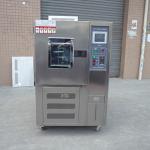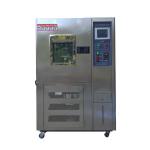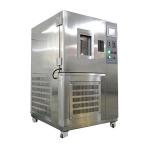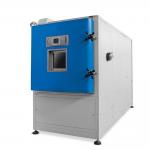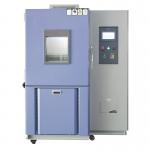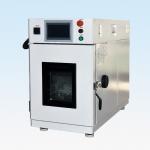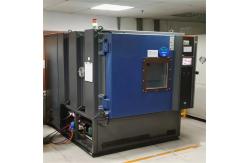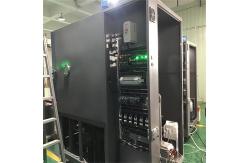In the realm of scientific research, aerospace engineering, and
various industrial applications, the ability to accurately simulate
and study low pressure conditions is of utmost importance. The
customized low pressure chamber emerges as a sophisticated and
indispensable tool, enabling precise control and analysis of
environments with reduced atmospheric pressure. This highly specialized chamber is designed to create and maintain
a wide range of low pressure settings. It caters to industries such
as aerospace, where it is used to test the performance and
durability of components and systems in the rarefied atmosphere of
high altitudes and outer space. In the field of research, it allows
scientists to investigate the effects of low pressure on biological
organisms, materials, and chemical reactions. The primary goal is
to replicate the hypobaric conditions that are encountered in
specific real-world scenarios, providing a platform for
experimentation, quality assurance, and innovation. - Robust and Airtight Chamber Construction
- The low pressure chamber is constructed with a heavy-duty steel
frame that provides exceptional strength and rigidity. The chamber
walls are made of high-strength alloy materials that can withstand
the significant pressure differentials. The interior is carefully
sealed with advanced sealing technologies, such as double O-ring
seals and vacuum-tight gaskets, ensuring an airtight enclosure. The
door is designed with a reliable locking mechanism and a
pressure-assisted sealing system to maintain the integrity of the
low pressure environment. The chamber is also equipped with safety
valves and pressure relief systems to prevent over-pressurization
and ensure the safety of operators and the equipment.
- Precision Pressure Control System
- The chamber features a highly accurate pressure control system. It
can achieve a wide range of pressure levels, from near-vacuum
conditions, typically as low as 10^-6 torr, to pressures equivalent
to high-altitude environments, such as 10 kPa or higher. The system
utilizes advanced vacuum pumps, pressure regulators, and sensors.
The sensors continuously monitor the pressure inside the chamber
and provide real-time feedback to the control unit. The control
unit then adjusts the pumping rate and valve settings to maintain
the desired pressure level with an accuracy of ±0.1% of the set
value. This level of precision allows for highly controlled and
repeatable experiments.
- Temperature and Humidity Regulation Capabilities
- In addition to pressure control, the chamber also offers the
ability to regulate temperature and humidity. The temperature can
be maintained within a range of -40°C to +150°C, with an accuracy
of ±0.5°C. The humidity control range extends from near-zero
dryness to saturated conditions, with an accuracy of ±2% RH.
Temperature and humidity can have significant impacts on the
behavior of materials and biological samples under low pressure.
The chamber's control system ensures that these environmental
factors are precisely controlled, providing a more comprehensive
simulation of real-world conditions.
- Intuitive Control and Data Acquisition Interface
- The equipment is equipped with an intuitive control panel that
allows operators to easily set and adjust the pressure,
temperature, humidity, and test duration. The control panel also
provides real-time displays of the current values of these
parameters, as well as any alarms or warnings. The chamber is
integrated with a comprehensive data acquisition system. It records
all relevant test data, such as pressure profiles, temperature and
humidity histories, and any changes in the physical properties of
the test samples. The data can be stored in a built-in memory or
exported to external storage devices for further analysis. The
system can also generate detailed test reports in various formats,
facilitating easy documentation and sharing of results.
- Versatile Sample Fixturing and Monitoring Options
- The interior of the low pressure chamber is designed to accommodate
a variety of sample sizes and shapes. It can be equipped with
adjustable racks, trays, and holders to ensure proper sample
positioning and exposure. The chamber is also fitted with
observation windows and ports for connecting external monitoring
and measurement devices. This allows for real-time monitoring of
the samples during the test, such as the measurement of gas
emissions, mechanical deformation, or biological responses. The
sample fixturing is made of materials that are compatible with the
low pressure and other environmental conditions and do not
contaminate the test environment.
- Pressure Range and Accuracy
- The chamber can maintain a pressure range from 10^-6 torr to 10 kPa
or higher, with an accuracy of ±0.1% of the set value. This wide
range enables the simulation of conditions from deep space vacuum
to high-altitude flight. For example, in aerospace testing,
components like aircraft cabin pressurization systems or satellite
electronics can be tested under the exact pressure conditions they
will encounter in operation.
- Temperature Range and Rate of Change
- The temperature range of -40°C to +150°C allows for the simulation
of a diverse range of climatic and thermal conditions. The rate of
temperature change can be adjusted up to 10°C per minute. This
rapid temperature change capability is useful for testing the
thermal stability of materials and systems in combination with low
pressure exposure. For instance, in the development of new
materials for space exploration, their performance under rapid
temperature swings in a low pressure environment can be evaluated.
- Humidity Range and Rate of Change
- The humidity range of near-zero to saturated conditions, with a
rate of change of up to 5% RH per minute, provides a comprehensive
assessment of the effect of moisture on low pressure processes.
High humidity can affect the behavior of biological samples or
cause condensation issues on materials, while low humidity can lead
to drying and cracking. The ability to control humidity precisely
helps in understanding the complex interactions between low
pressure, temperature, and humidity.
- Testing Volume and Payload Capacity
- The chamber offers a customizable testing volume, with options
ranging from 1 m³ to 20 m³. The payload capacity can be adjusted
according to the size and weight of the test samples, with a
maximum capacity of up to 5000 kg. This allows for the testing of a
significant number of samples or larger and heavier products. For
example, in the aerospace industry, full-scale aircraft components
or even small spacecraft modules can be tested.
|
